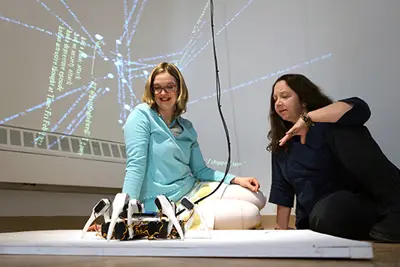Teacher of Photography Wins $15,000 Mass Cultural Council Grant

09/03/2019
By David Perry
Pavel Romaniko, visiting assistant professor in the Art & Design department, has been busy lately. As the spring semester ended, Romaniko and his wife welcomed a baby son. He also welcomed a $15,000 fellowship from the Mass Cultural Council.
Born outside of Moscow, the 39-year-old Romaniko teaches photography at UML, and his work in that medium is what captured the fellowship. For his ongoing series, Nostalgia, he constructed actual paper mini-sets symbolizing the politics, history and his own memory of Russia, which he left for the U.S. at 17 years old.
Romaniko discussed his work, his plans for his grant money and how Lowell fits into this work.
Q: What informs the work in Nostalgia? Is it observations of your homeland?
A: I wish I could give a short summary, but I spent over 10 years on this work. It’s a sort of political and pop culture satire, a sort of mix. I work with paper and, as my wife jokes, I play with dollhouses. What I do is look at existing images. I take iconic images from history books and then I reconstruct them with my own twist, a reinterpretation. I revisit them regularly. In most cases, I don’t try to create an illusion. If you look closely, you’ll see clamps up here. You’ll see the staples where the paper is assembled. They’re not really trying to be authentic-looking. Some are more disguised than others. If you see the pieces, they’re fairly large, and you can totally tell they’re fake.

Q: How did you get into photography?
A: I was a failed painter. I was a lazy painter. I started painting and printmaking as an undergrad. I started traveling. I was a transplant from Russia. In college, I started studying design. Then I transitioned into painting. I started taking reference images in Russia. I’d go in and photograph on a cheap camera. I was doing return trips every year to see my family. I started re-photographing the same thing over and over, and I realized there’s something very interesting here that I can never achieve with a paintbrush, not at the rate I was doing it. I photographed things again and again, looked at them side by side and realized I’m holding on to something that’s really interesting.
Q: You have this $15,000 Mass Cultural Council grant now. What are you going to do with that?
A: I have a museum show in the fall at the Museum of Russian Icons in Clinton. So probably some of it will go into preparing for that show, because it’s a large space and I’d like to make more work. I haven’t made any new pieces in a while.
Q: How does Lowell fit into the work you do?
A: I’ve been looking at photographic archives. People like Lewis Hine (an American sociologist and photographer who used his camera as a tool for social reform) spent time working here. There’s a rich history of social causes. Hine believed that photography was a way to get facts to make posters. He would sneak cameras into factories, because the cameras were becoming smaller and you could take them in there, and people would look at the pictures and all of a sudden, they told a story. Here’s a child. Another child. There’s a child with a missing limb. Hine spent a good chunk of his time here in Lowell, actually.
Also, I live in Waltham in an original Francis Cabot Lowell factory, in the loft where he started the model for Lowell.




